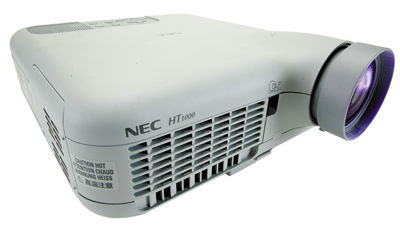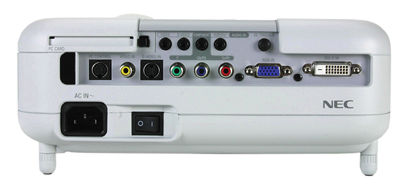NEC HT1000 DLP projector

Of course, to the non-videophile, a 7-pound box that looks like a miniature slide projector but costs $5500 is also hard to believe. Why so much?
"Why so much?" is easy to answer. NEC's little HT1000, like all DLP displays, is a lot more complicated than it looks. How good can it be? It won't display high-definition in full resolution, but it produces images from standard-definition sources that are amazingly close in quality to those from DLP projectors selling for twice as much. Or more.
What It Does
The HT1000 appears to be based on one of NEC's business models, the LT240. Included are many capabilities apparently carried over from business applications, many of them functional only with the RGB input. I won't go into most of those in any detail here.
Still, the HT1000 is loaded with features that will be of interest to home-theater fans. At its heart is Texas Instruments' latest 1024x768 (4:3) Digital Micromirror Device (DMD), with 12"° mirror deflection for improved contrast. Also included are a six-segment color wheel; a fully sealed light path to keep out dust and other impurities; Faroudja's FLI2200 deinterlacing chip; NEC's 3D Reform technology, which allows the projector to be positioned almost anywhere in the room and still produce a properly aligned image; a cooling fan that, in its EcoMode, is very quiet; a 10-bit 3D video decoder; and a digital photo viewer for display of digital photos from a PC card or Compact Flash. There's also a complete range of aspect ratios, including a true 16:9 mode for correct display of enhanced (anamorphic widescreen) DVDs, and a nonlinear stretch mode for expanding 4:3 material to fill a 16:9 screen.
The HT1000 offers a full range of inputs, including DVI with HDCP compatibility. Its manual-zoom, manual-focus lens has a throw distance of approximately 1.54–1.85x screen width. A mechanically adjustable iris in the lens can, in some circumstances, enhance image contrast. The projector is compatible with all forms of NTSC, PAL, and SECAM, and it will display images originating as 480i, 576i, 480p, 576p, 720p, 1080i, and even 1080p, downconverting most of these to a maximum of 1024x768.
But the highest resolution you'll get from the NEC in its 16:9 screen setting is 1024x576 (the rest of the chip remains unused). The same holds true for hi-def material. The projector can display a widescreen hi-def source, but the image is downconverted to a resolution of 1024x576. In the same 16:9 setting, a 4:3 image is displayed in the middle of a 16:9 screen with gray bars at the right and left (unless you use that nonlinear stretch mode).
You may be wondering at this point how you might take advantage of the DMD chip's full 1024x768 resolution for 4:3 images. You can, if you select the 4:3 screen setting. When I tried this, the image actually looked softer than in the 16:9 setting, even with the added pixels. This may have simply been artificial sharpness from the less-dense pixel structure (though it didn't look artificial), or it might have resulted from differences in the way the projector was processing the image at the two different screen settings.

If you have a 4:3 screen, the image will stay centered on the screen as you switch the projector between the 16:9 screen mode (which you should use for proper playback of HD material and anamorphic DVDs—keep your DVD player set to 16:9 for maximum resolution with the latter) and 4:3 screen mode (to fill the screen with 4:3 material while using all the pixels on the 1024x768 chip). But if you do the same on a 16:9 screen, you'll have to zoom the image down to fit in the center of the screen. The zoom will alter the vertical position of the picture, requiring that you reposition the projector—not a practical option, particularly if it's ceiling-mounted.
My advice: Stick to a 16:9 screen and the HT1000's 16:9 setting. It's clearly the best mode for home-theater use.
The HT1000 includes a host of other features for optimizing setup. There is no mechanical vertical lens shift of the sort found on many more expensive DLP projectors, but to help center the image on your screen in the 16:9 mode, you can electronically move the image up and down within the relatively limited range of the unused vertical areas of the 4:3 DMD. This position adjustment can't be used when the HT1000 is set up for a 4:3 screen.
Its picture controls provide the HT1000 with adjustment capabilities second to none among the projectors we've reviewed. There are horizontal, vertical, and diagonal digital keystone correction, a three-position overscan control (best left in the "0%" position), a three-position video filter and noise-reduction control, a three-position gamma control, a six-position Black Expansion control, and a seven-step adjustment called Contrast Enhancement.
There are also six different preset gray-scale settings and a user setup option. If you choose the user preset (called White Balance here), you get full control over red, green, and blue at both the top and bottom of the brightness range. In addition, you can control the overall levels of red, green, blue, yellow, magenta, and cyan.




























































